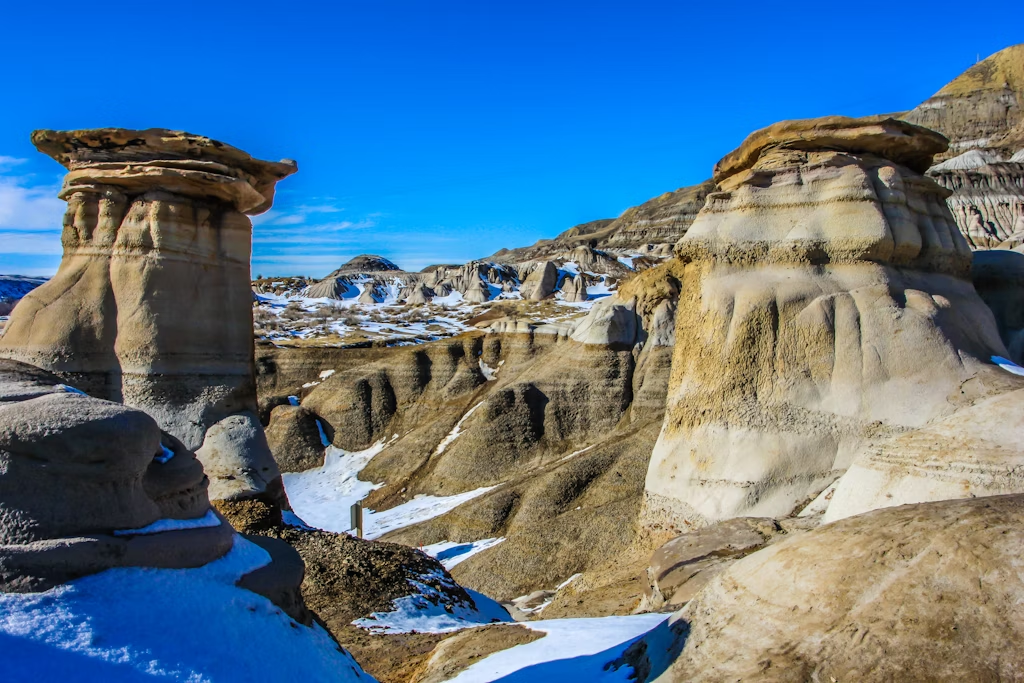Alberta is home to some of the most awe-inspiring scenery on the planet: rugged snow-capped mountains, massive glaciers, thick forests, impossibly blue lakes, vast prairies and other-worldly badlands filled with dinosaur bones. It’s a nature lover’s paradise, but that's only one side of this remarkable destination.

First Nations, Métis and Inuit Peoples have lived on and cared for these lands for thousands of years and are still present here – Alberta is home to remarkable Indigenous places and experiences. Its two largest cities, Edmonton and Calgary, are extremely multicultural, each with its own unique cosmopolitan flare. Meanwhile, cowboy culture lives on in small towns, farms and ranches that dot the prairie regions.
There’s much to love about Alberta. It’s a destination so packed with possibilities that it can be difficult to decide where to start. Here’s how to make the most of a visit to this extraordinary Canadian province.
How many days do you need in Alberta?
Ideally, you’ll spend at least two or three days exploring Calgary or Edmonton. It won’t give you enough time to see everything, but it's enough to hit the highlights. Tack on extra time if you’re visiting the Calgary Stampede, the Edmonton International Fringe Theatre Festival or any other iconic festival in the area.
If you don’t mind moving fast, you could explore the Canadian Rockies in Banff, Lake Louise and Jasper in about a week. That would give you two or three days in the Banff and Lake Louise area, one day to drive the Icefields Parkway and two or three days to explore Jasper. Add at least two more days to explore the Canadian Badlands region of the province, where you’ll discover a mind-blowing, arid landscape filled with dinosaur fossils, hoodoos and other land formations.
Why not extend your trip and fully explore excellent Edmonton? Our first-timer's guide has everything you need to know.

What is the 1 tourist attraction in Alberta?
Established in 1885, Banff National Park was Canada’s first national park (and the world’s third) and is one of Canada’s top travel destinations. More than four million people visit this incredible park every year. Banff has something for hardcore adventurers, the bus tour seniors crowd and everyone in between. The discovery of Banff Hot Springs and a subsequent dispute over their ownership prompted the park's creation, and you can still soak in their healing waters.
The park is filled with breathtaking mountain scenery, including two of the most beautiful lakes on the planet: Lake Louise and Moraine Lake. As you drive, ski or hike through it, you’ll see rugged mountains, glaciers, lakes, valleys and abundant wildlife, including deer, elk, moose and bears. It’s the busiest and most developed park in the Canadian Rockies, with wonderful hotels and restaurants, three world-class ski resorts, a challenging golf course and a bustling town with loads of amenities for tourists.
When should I visit Alberta?
The short answer is anytime – Alberta is a four-season destination. The weather is warmest in the summer months with average temperatures of 20°C to 25°C (68°F to 77°F) from June through September. Summer is the busiest travel season when hotel prices are at their peak.
Winters are cold with average daytime highs of -5°C to -15°C (23°F to 5°F), but temperatures can dip as low -30°C (-22°F) for shorter periods of time. If you’re a fan of winter sports and hiking, this is a great time to visit, though accommodation prices go up during the Christmas season.
You’ll find lower prices in the Rockies and elsewhere in the province during the shoulder seasons in fall (October through November) and spring (May to June). Crowds are smaller in the shoulder seasons but some facilities and trails are closed.
Where should I stay in Alberta?
There are many options when it comes to accommodations in Alberta. Many hostels have private rooms with private bathrooms for a fraction of the cost of a hotel room. Parks Canada and Alberta Parks both offer comfort camping sites that range from fully equipped tents with beds in them to fully equipped cabins. B&Bs are a comfortable mid-range option that allow you to meet locals and usually include breakfast. Hotel accommodations range from budget family-owned motels to high-end luxury properties like the Fairmont Banff Springs, also known as “the castle in the Rockies.”
Backcountry lodges are one of the more unique accommodations in the Rockies. You typically need to hike, ski, ride on horseback or take a helicopter in to reach the property, but these comfortable lodges offer delicious, home-cooked meals and an escape from the crowds. A ranch or farm stay is another unique option that offers a glimpse into cowboy culture.
In Edmonton, the Fantasyland Hotel at West Edmonton Mall has a variety of themed suites, from an igloo room to a Western room to a Polynesian room. At Métis Crossing, guests can stay in a comfortable lodge, a fully equipped trapper’s tent or in a circular Sky Watching Dome that lets you observe the night sky while you lie in bed.

Is it easy to get around in Alberta?
Alberta is a big province, and you’ll need a car to visit more remote places, small towns and provincial and national parks. Public transit is excellent in Edmonton, Calgary and Banff, and taxis and Uber are available there and in other larger cities. All three destinations are also very walkable. Several companies offer shuttle services between Calgary and Banff. Between Edmonton and Jasper, Via Rail offers train services, and Sundog Tours offers a shuttle bus service.
Top things to do in Alberta
Visit a UNESCO World Heritage Site
There are six UNESCO World Heritage Sites in Alberta, and each one is a unique experience:
- Canadian Rocky Mountain Parks include Banff and Jasper, Kootenay and Yoho national parks, and Mount Robson, Mount Assiniboine and Hamber provincial parks in British Columbia. These parks protect a striking mountain landscape.
- Dinosaur Provincial Park was recognized for its remarkable landscape and the huge number of high-quality Cretaceous fossils found here. This includes about 35 species of dinosaurs, dating back 75 million years.
- Head-Smashed-In Buffalo Jump is one of the oldest, most extensive and best-preserved buffalo jumps in the world, and it was used by the Indigenous Plains People for nearly 6000 years.
- Waterton Glacier International Peace Park includes Waterton Lakes National Park in Alberta and Glacier National Park in Montana, which together formed the world’s first international peace park. These parks are situated at the Crown of the Continent and protect stunning scenery and many plants and animals.
- Wood Buffalo National Park is Canada’s largest park containing some of the largest undisturbed grass and sedge meadows left in North America. It’s also home to North America’s largest herd of wild bison and the only breeding habitat in the world for the endangered whooping crane.
- Writing-on-Stone Provincial Park / Áísínai’pi is a sacred landscape that provides exceptional testimony to the living cultural traditions of the Blackfoot People. This site contains the largest concentration of Indigenous rock art on the North American plains.
Hike, cycle or ski along a trail in Kananaskis Provincial Park
You drive right through Kananaskis when you are traveling from Calgary to Banff, and it’s worth a stop. This stunning park has beautiful mountain scenery and lovely hiking trails – two of my favorites are the Ptarmigan Cirque and the Grassi Lakes Trail. Rent mountain bikes in summer or cross-country skis in winter at Kananaskis Outfitters, or you can book trail rides and dogsledding at Boundary Ranch.
Nakiska offers exceptional downhill skiing and was the host of the alpine ski events at the 1988 Winter Olympics. If you want to experience the thrill of a whitewater rafting trip in Banff, it will probably happen in Kananaskis. Rest and treat your tired muscles after all your outdoor adventures at the Kananaskis Nordic Spa in Pomeroy Kananaskis Mountain Lodge, Alberta’s only Nordic Spa.

Explore Banff National Park
Canada’s first national park is a vast area with incredible scenery and activities in every season. In winter, you can skate on a frozen lake, go on a guided ice walk of Johnston Canyon, enjoy fat biking or spend your day skiing at one of the three world-class ski resorts.
In summer, you can take a boat cruise on Lake Minnewanka, stretch your legs on a hike, watch for grizzly bears while you ride the Lake Louise Summer Gondola, test your head for heights and climb a via ferrata, paddle a canoe on Lake Louise and many more activities. Banff Upper Hot Springs, top-notch spas and the fantastic food and drink scene can be enjoyed year-round.
Drive the Icefields Parkway
The 230km (143-mile) Icefields Parkway from Lake Louise to Jasper is one of the prettiest drives in the world. You’ll pass more than 100 glaciers and other incredible sites along the way, including the Columbia Icefield area and the Athabasca Glacier, Tangle Falls, Sunwapta Falls and Athabasca Falls.
There are some incredible day hikes along the parkway, including Mistaya Canyon, Peyto Lake Viewpoint, Parker Ridge and Wilcox Pass. Some visitors stop at the Columbia Icefield Glacier Discovery Centre near the Athabasca Glacier to enjoy a Columbia Icefields Adventure Tour that takes guests in a special vehicle onto the surface of the ancient glacier. Experience the Icefields Parkway without the crowds by booking an overnight stay at the Glacier View Lodge.
Have an Indigenous tourism experience
Alberta is filled with amazing Indigenous tourism sites and experiences right across the province, including two UNESCO World Heritage Sites. If you’re attending the Calgary Stampede, make sure to visit Elbow River Camp and attend the Calgary Stampede Powwow. Southeast of Calgary, Blackfoot Crossing Historical Park has exhibits and tours that offer an authentic Blackfoot cultural experience.
In Edmonton, you shouldn’t miss the Indigenous People’s Experience at Fort Edmonton Park, a multi-media exhibition that tells the stories and shares the cultures of the Indigenous Peoples of this region of Canada. Visit Métis Crossing, northeast of Edmonton, to learn about Métis culture and enjoy fun activities like paddling a voyageur canoe and taking a wildlife tour to see sacred white bison.
Have an epic adventure in Jasper National Park
Jasper National Park is filled with epic adventures, and the Maligne Canyon hike is one of them. In summer, you can feel the mist on your face from roaring waterfalls, and in the winter, it becomes a wonderland of fascinating ice formations that can be experienced on an ice walk tour.
Other park adventures include taking a cruise on Maligne Lake to Spirit Island, riding the Jasper Sky Tram to the top of Whistlers Mountain, paddling a canoe or skating on Pyramid Lake and viewing the stars in one of the world’s largest and most accessible dark sky preserves. The annual Jasper Dark Sky Festival is one of the highlights of visiting Jasper in October.

Hunt for fossils in the Canadian Badlands
The Canadian Badlands in southeast Alberta feature arid landscapes like nowhere else on earth and some of the world’s largest deposits of dinosaur fossils. Join in on a bus tour, a hike or a fossil excavation with real paleontologists in Dinosaur Provincial Park or visit the Royal Tyrrell Museum in Drumheller, one of the top dinosaur museums in the world.
When you've had your fill of dinosaurs, take a trip through Horseshoe Canyon and experience the unique landscape of the badlands up close, then explore ghost towns like Wayne and coal mining history at Atlas Coal Mine National Historic Site.


You must be logged in to post a comment.